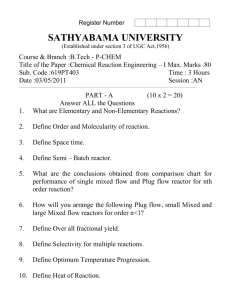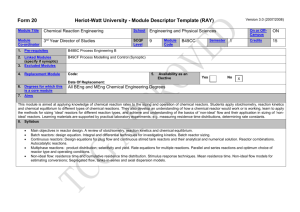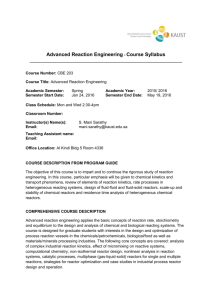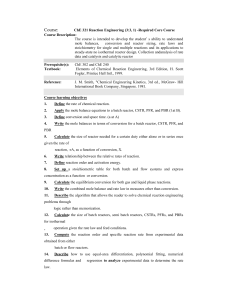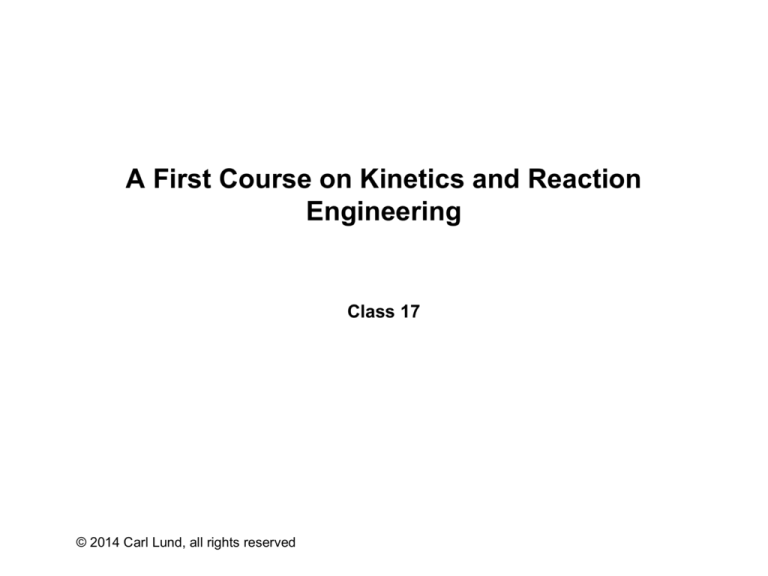
A First Course on Kinetics and Reaction
Engineering
Class 17
© 2014 Carl Lund, all rights reserved
Where We’re Going
• Part I - Chemical Reactions
• Part II - Chemical Reaction Kinetics
• Part III - Chemical Reaction Engineering
‣ A. Ideal Reactors
-
17. Reactor Models and Reaction Types
‣ B. Perfectly Mixed Batch Reactors
‣ C. Continuous Flow Stirred Tank Reactors
‣ D. Plug Flow Reactors
‣ E. Matching Reactors to Reactions
• Part IV - Non-Ideal Reactions and Reactors
Reaction Engineering
• Objectives
‣ Construct accurate mathematical models of real world reactors
‣ Use those models to perform some engineering task
• Tasks
‣ Reaction engineering: studies involving an existing reactor
‣ Reactor design: specifying a reactor that doesn’t yet exist along with its operating procedures
• Real world reaction engineering
‣ Maximize the rate of profit realized by operating the overall process (not just the reactor)
‣ Integration of the reactor into the overall process may place constraints upon the reactor
design and operating conditions
• Generally
‣ generate the desired product as fast as possible
‣ with the highest selectivity possible
‣ using as little energy as possible
‣ in as small a reactor volume as possible
‣ while maintaining
-
reliability
operability
environmental compatibility
safety
Ideal Reactor Design Equations
Batch Reactor
dni
=V
dt
å
j=all
reactions
CSTR
n i, j rj
Ideal Reactor Design Equations
Steady State CSTR
PFR
Ideal Reactor Design Equations
Steady State RFR
(Unpacked Tube)
é 150 (1- e ) m
ù
¶P
1- e
G2
=- 3
+1.75ú
ê
¶z
e rF s Dp gc êë F s DpG
úû
(Packed Bed)
Typical Kinetics Behavior
and Reaction Classification
• Typical kinetics behavior
‣ As T increases, the rate increases
-
final conversion decreases for exothermic; increases for endothermic reactions
‣ As concentration or partial pressure of reactants decreases, the rate decreases
‣ As the concentration or partial pressure of products increases, the rate decreases for
reversible reactions; is not strongly affected for irreversible reactions
• Reaction Classification
‣ Auto-thermal reactions: the (exothermic) heat of reaction is sufficiently large to heat the
reactants to reaction temperature
‣ Auto-catalytic reactions: rate increases as the product concentration increases
‣ Reactant Inhibited Reactions: rate decreases as the reactant concentration increases
‣ Product Inhibited Reactions: rate decreases as the product concentration increases
‣ Parallel Reactions
-
A→B
A→C
‣ Series Reactions
-
A→B
B→C
‣ Series-Parallel Reactions
-
A+B→R+S
R+B→T+S
Questions?
Activity 17.1
• Liquid phase reactions (1) and (2) below take place in an adiabatic batch
•
•
•
•
•
•
reactor.
A+B⇄R+S
(1)
R⇄T+U
(2)
The initial temperature of the 2 m3 reactor is 450 K and it initially contains
3.5 kmol m−3 each of A and B (the only species present). Heat capacities
of the species, in cal mol−1 K−1, are as follows: A = 7.5, B = 8.5, R = 9.3, S
= 12.1,
T = 5.7, and U = 6.3. The reactions are elementary with rate coefficients
as given below.
k1 = (8.3 x 10−2 m3 kmol−1 s−1) exp{−(18,000cal mol−1)/(RT)}
(3)
k2 = (3.7 x 10−3 s−1) exp{−(13,500cal mol−1)/(RT)}
(4)
The reactions are irreversible with ΔH1(298 K) = −9870 cal mol−1 and
ΔH2(298 K) = −8700 cal mol−1. How long will it take for the concentration
of S to reach 2.5 kmol m−3?
• Write the mole and energy balance design equations for this system,
expanding all sums and continuous products
Activity 17.2
• Aqueous phase reactions (1) and (2) below take place in an adiabatic
•
•
•
•
•
•
CSTR operating at steady state.
A+B⇄R+S
(1)
A+B⇄T+U
(2)
The feed to the 2 m3 reactor is at 78ºC and it initially contains A and B at
equal 1.5 M concentrations. The heat capacity of the solution may be
taken to equal that of water, 1 cal g-1. The reactions are elementary with
rate coefficients as given below.
k1 = (8.3 x 10−2 m3 kmol−1 s−1) exp{−(8,000cal mol−1)/(RT)}
(3)
k2 = (4.7 x 10−2 m3 kmol−1 s−1) exp{−(12,000cal mol−1)/(RT)}
(4)
The reactions are irreversible with ΔH1(298 K) = 9870 cal mol−1 and
ΔH2(298 K) = 8700 cal mol−1. Heat is added to the reactor by passing
saturated steam at 120ºC through a coil with an area of 0.7 m2 that is
submerged in the solution. The overall heat transfer coefficient is
25 BTU h-1 ft-2 ºF
• Write the mole and energy balance design equations for this system,
expanding all sums and continuous products
Activity 17.3
• Suppose the steam being fed to the submerged coil was suddenly
changed to saturated steam at 100ºC, write the design equations needed
to model the reactor.
Where Were Going
• Part I - Chemical Reactions
• Part II - Chemical Reaction Kinetics
• Part III - Chemical Reaction Engineering
‣ A. Ideal Reactors
-
17. Reactor Models and Reaction Types
‣ B. Perfectly Mixed Batch Reactors
-
18. Reaction Engineering of Batch Reactors
19. Analysis of Batch Reactors
20. Optimization of Batch Reactor Processes
‣ C. Continuous Flow Stirred Tank Reactors
‣ D. Plug Flow Reactors
‣ E. Matching Reactors to Reactions
• Part IV - Non-Ideal Reactions and Reactors

